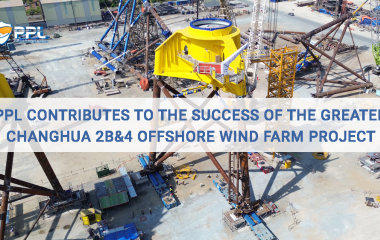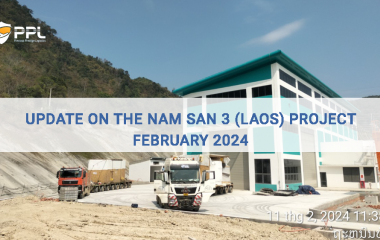Offshore wind power - Solutions to solve challenges in grid connection
Offshore wind power projects develop with a much larger scale and capacity than other renewable energy projects. These projects can have large capacity equivalent to thermal power plants, so it is necessary to develop the power grid and infrastructure accordingly.
La Gan offshore wind power project (Binh Thuan) is expected to produce a total capacity of 3,500 MW after being fully operational. With such capacity, it can provide electricity for more than 7 million Vietnamese households annually.
It can be seen that the connection of such large-scale offshore wind power projects has many advantages over other renewable energy sources, because it avoids many of the significant limitations that renewable energy projects have. on the shore are encountered.
In this article, readers, let's go with PPL to find out what challenges offshore wind power will overcome in grid connection.
What difficulties are renewable energy projects facing?
1. Limited land fund for renewable energy project development
To connect a renewable energy project to the grid requires a large land bank. Now, land constraints are one of the key priorities that are carefully considered and managed when developing renewable energy projects to ensure timely connectivity and avoid conflicts over usage as well as classifying the land fund or land in the planning.
Onshore wind power and solar power often face a lot of limitations in terms of topography and terrain for installation and operation such as: sun direction, hard rock foundation, entrance to the building,... may affect the selected location, project selection and execution. This increases risks in other aspects such as flooding, ground stability and conflicts with communities around the project area.
As for offshore wind power, most of the infrastructure is located at a fairly long distance from the coast (wind turbines, foundations, transformer stations, cable lines... are mostly located offshore). It helps to minimize the onshore infrastructure (for transmission only).
 Limited land fund for renewable energy project development
Limited land fund for renewable energy project development
2. Infrastructure for electrical connection
For renewable energy projects, it is very important to connect to the grid, needing the right infrastructure. But at present, onshore wind and solar power projects often have low annual equipment capacity factors (20-30%).
These small and medium sized projects are regularly connected to the national grid at voltage levels of 220 kV or 110 kV or less, thus also contributing a smaller capacity to the grid.
Offshore wind power can overcome this difficulty because it can provide an annual capacity factor of nearly twice that of onshore wind, solar and connected at higher voltages (229 kV, 500 kV).
3. Legal provisions on investment and construction of transmission lines
Currently, there are no regulations and guidelines on allowing economic sectors other than the State to invest in the construction of connecting transmission lines, but the recent amendment of the Electricity Law has allowed the private sector to invest in the construction of transmission lines. invest in these transmission lines.
If there are clearer regulations, project developers may consider investing in whole or in part in line construction/grid upgrading in close cooperation with the operator to minimize risks and ensure projects can be delivered on time.
Delays in grid construction and connection, uncertainty in forced generation cuts due to inadequate infrastructure and demand management can become major risks for developers, causing them to delay the commit until there is more certainty in the implementation.
4. Power supply capacity distribution
The national power system operator ensures that there is enough power to meet the daily load demand. Too many projects in low on-site load areas can lead to overcapacity and grid congestion (especially during off-peak times), resulting in strain on operators, even having to cut capacity (when generating capacity exceeds demand, forcing operators to cut down or stop generating electricity). The high level of reduction causes many concerns for the development of energy projects. commercially viable new renewables.
If an agreement on a specific capacity setting and a fixed price is reached between the offshore wind developer and the grid operator/relevant public authority, a project can be designed to provide high available power and has its own operating regulations.
Advantages and solutions to solve challenges in electrical connection of OVERSIDE WIND POWER
The connection point of an offshore wind power project is usually located close to the onshore grid connection point. However, this is not always possible and the length of the onshore cable from the land contact to the onshore substation can be quite large.
To overcome this, experienced developers can consider investing in building/upgrading part of the high-voltage transmission system. This can ensure more efficient and timely upgrades to enhance regional grid transmission capacity, strengthen systems, reduce risks, and avoid power cuts.
Advantages of offshore wind power
1. Large capacity and high stability
Compared with onshore wind, the quality and stability of offshore wind are generally better. Especially in the area of Binh Thuan and Ninh Thuan, this is where the offshore wind source is assessed to have better quality than the onshore wind.
In an offshore wind project, the wind turbines will be larger in size than the onshore wind, which helps the offshore wind project achieve an exceptionally high annual capacity factor, which typically ranges from 40 up to 60% for large-scale offshore wind power projects.
La Gan wind power project, developed by Copenhagen Infrastructure Partners and local partners, can provide a stable source of renewable energy with a high capacity (3,500 MW).
 Advantages of offshore wind power
Advantages of offshore wind power
2. Priority funding
Many global banks and financial institutions prioritize funding for renewable energy projects, especially offshore wind power. This is an opportunity for experienced and capable developers, raising capital will be more favorable in the global trend towards reducing emissions. Countries where the offshore wind industry has developed show a high level of investment in the industry's technology.
Globally, there are increasing commitments to reduce dependence on fossil fuels and reduce carbon emissions by promoting renewable energy. Vietnam is no exception, Vietnam has made a strong commitment at COP26 to achieve net-zero carbon emissions by 2050. This is an ambitious goal but achievable with legal frameworks in place. and appropriate support policies.
And renewable energy power in general and offshore wind power in particular are solutions to help Vietnam step by step realize the committed goals at COP26.
Hope this article brings readers useful information. Please continue to follow PPL to receive the next useful information.
According to Vietnam Energy Magazine
Related Posts
New Posts
- Vietnam Holiday Announcement
- PPL contributes to the success of the Greater Changhua 2b&4 Offshore Wind Farm Project
- Update on the Nam San 3 (Laos) Project February 2024
- PPL HAPPY NEW YEAR 2024
- LUNA NEW YEAR HOLIDAY 2024 ANNOUNCEMENT
- PPL CONDUCTS A CHARITY PROGRAM OF FREE MEDICAL EXAMINATIONS, CONSULTATIONS, AND MEDICATION DISTRIBUTION IN THAI BINH PROVINCE







Comments